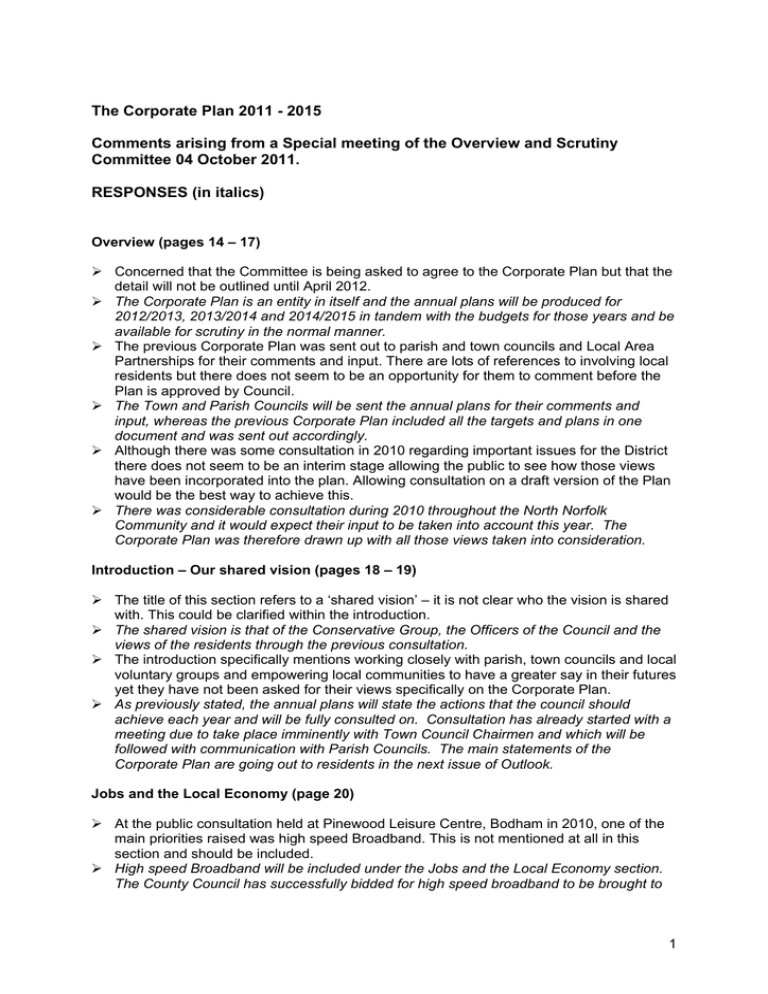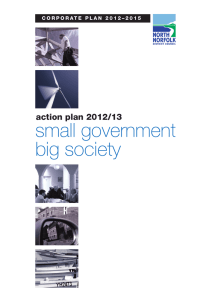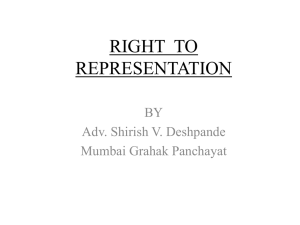Document 12926976
advertisement

The Corporate Plan 2011 - 2015 Comments arising from a Special meeting of the Overview and Scrutiny Committee 04 October 2011. RESPONSES (in italics) Overview (pages 14 – 17) ¾ Concerned that the Committee is being asked to agree to the Corporate Plan but that the detail will not be outlined until April 2012. ¾ The Corporate Plan is an entity in itself and the annual plans will be produced for 2012/2013, 2013/2014 and 2014/2015 in tandem with the budgets for those years and be available for scrutiny in the normal manner. ¾ The previous Corporate Plan was sent out to parish and town councils and Local Area Partnerships for their comments and input. There are lots of references to involving local residents but there does not seem to be an opportunity for them to comment before the Plan is approved by Council. ¾ The Town and Parish Councils will be sent the annual plans for their comments and input, whereas the previous Corporate Plan included all the targets and plans in one document and was sent out accordingly. ¾ Although there was some consultation in 2010 regarding important issues for the District there does not seem to be an interim stage allowing the public to see how those views have been incorporated into the plan. Allowing consultation on a draft version of the Plan would be the best way to achieve this. ¾ There was considerable consultation during 2010 throughout the North Norfolk Community and it would expect their input to be taken into account this year. The Corporate Plan was therefore drawn up with all those views taken into consideration. Introduction – Our shared vision (pages 18 – 19) ¾ The title of this section refers to a ‘shared vision’ – it is not clear who the vision is shared with. This could be clarified within the introduction. ¾ The shared vision is that of the Conservative Group, the Officers of the Council and the views of the residents through the previous consultation. ¾ The introduction specifically mentions working closely with parish, town councils and local voluntary groups and empowering local communities to have a greater say in their futures yet they have not been asked for their views specifically on the Corporate Plan. ¾ As previously stated, the annual plans will state the actions that the council should achieve each year and will be fully consulted on. Consultation has already started with a meeting due to take place imminently with Town Council Chairmen and which will be followed with communication with Parish Councils. The main statements of the Corporate Plan are going out to residents in the next issue of Outlook. Jobs and the Local Economy (page 20) ¾ At the public consultation held at Pinewood Leisure Centre, Bodham in 2010, one of the main priorities raised was high speed Broadband. This is not mentioned at all in this section and should be included. ¾ High speed Broadband will be included under the Jobs and the Local Economy section. The County Council has successfully bidded for high speed broadband to be brought to 1 ¾ ¾ ¾ ¾ ¾ ¾ ¾ ¾ Norfolk by 2015. There is already a pilot scheme going ahead in Sheringham. We will work with the County Council and BT and ensure that this is in the action plans. It is not clear what ‘Streamline local regulatory processes’ means – perhaps this could be made clearer. This is exactly what it says. We have to cut red tape and simplify processes within the council. Improving access to funding for local businesses – it is not clear how this falls within the Council’s remit. If the Council is intending to provide loans to businesses then this should be stated within the Plan. What the Council will do will be stated within the Action Plans under Jobs and the Local Economy. There is no reference to young people in this section at all. They could be included within the section on improving job prospects. The whole Action Plan under Jobs and the Local Economy is directly relevant to young people as they are an integral and vital part of the future of North Norfolk. Tourism is listed last perhaps it could be moved to the top of the list in recognition of it’s importance to the district. Tourism is highly important, as are broadband and young people. This will all be covered under Jobs and the Local Economy in the action plans. Housing and Infrastructure (page 21) ¾ Within the first box ‘What we want to achieve’ there is a reference to reducing the number of empty homes. However, there is no mention of empty homes and how this will be achieved in the adjacent ‘action’ box. ¾ You are right, there is no specific detail in the Corporate Plan and this was a deliberate decision to ensure simplicity of intent. These will all be included in the annual action plans. (You may by now have realised that we have a plan already in place to deal with empty homes and it is having an immediate effect.) ¾ There is no mention of second homes within this section – are there any safeguards proposed to prevent speculative developments and restrict the number sold to second homeowners. ¾ Second homeowners are actually quite important to North Norfolk. We must ensure, though, that they are paying their way and any adverse impact of second homes is being mitigated. Coast, Countryside and Built Heritage (page 22) ¾ The opening paragraph could mention the social importance of the coast, countryside and built heritage to locals perhaps by referring to ‘enjoyment and use’ of the countryside ¾ We wanted to keep all excess language out of the Corporate Plan. ¾ There could be a reference to working with other local authorities on the issue of coastal management – to share experiences and costs. ¾ This will definitely be included in the annual action plans because this is being worked on at present. ¾ There is no mention of controlling development along the foreshore – this is a concern to a lot of people. ¾ Should there be a change to the current position, this will be considered within the revised SMP and planning policy framework. 2 Localism (page 23) ¾ The first box seems to be attacking the Partnerships. It could be reworded to be more subtle and less aggressive while still achieving the original stated objective. ¾ The Council will be working more closely with the Town and Parish Councils as the bodies which have democratic legitimacy to decide on the issues in their areas. ¾ The Big Society Fund is mentioned but there is very little detail and no explanation of where the funding will come from. ¾ This is being worked on at present and will come to full council in due course. The funding will come from the second homes council tax which is being returned by the County Council to all of the District Councils directly. ¾ Local Area Partnerships are a vital means of delivering the Big Society vision and this should be acknowledged. ¾ Local Area Partnerships have done a fantastic job, however it is disappointing that none of them fulfilled their contracts that they should become self-financing by, originally 2006 and then extended to 2009. Over a quarter of a million pounds is taken out of the second homes money at present to finance staff and offices. That money should be available to the community for the projects they need help with. The LAPs should by now have become independent of the Council Tax funding by becoming voluntary or joining with other partners. ¾ For many people their main contact with the issue of Localism is via the planning process. The paragraph ‘Encourage the development of neighbourhood planning’ could be elaborated further to acknowledge this. ¾ Neighbourhood Planning is an integral part of the Coalition Government’s Localism Bill and North Norfolk is already embracing this new concept, especially in Holt and hopefully soon with other towns in the District. This will be supported by North Norfolk District Council with advice and funding if necessary. Our aspirations will be set out annually in the action plans. Delivering the Vision (page 24) ¾ The 4th listing referring to delivering priorities is the most important in this section and should be moved to the top of the listing. ¾ Thank you. The content was given careful consideration and it was decided to leave it as it was. ¾ The priorities of communities may not always be the same as those of the Council – perhaps it could state ‘Prioritise services and functions in line with the needs of our communities’ rather than ‘wishes of our communities’. ¾ Thank you, we will take that into consideration through our action plans. Financial Plan Update (this will be coming to Scrutiny in November – so only initial comments were taken) On page 30 (2.4.16) there is a reference to ‘deliberately misleading planning applications’. It is not clear what this means and how it is possible to make a misleading planning application. This is a reference to the Localism Bill and is explained below. The Government is concerned that some applicants for planning permission are deliberately misleading planning authorities about their proposals. This can happen where, for example, development is significantly different from the development that was granted planning permission, has been disguised as a different type of development, or 3 has been concealed completely. Two high profile cases, relating to developments in Hertfordshire and Surrey, are going through the courts at present, though both developments were built at least eight years ago. In the first, planning permission was granted for an agricultural barn but inside it was fitted out as a house, whilst in the second case the building of a 4-bedroom house was hidden behind straw bales and a tarpaulin. The Government wants to ensure that people who deliberately deceive the local planning authority about the nature of their intended development, or who conceal it until the window for enforcement action has expired, are no longer able to profit from this practice. The local planning authority would have to obtain a “Planning Enforcement Order” from the Magistrates’ Court to establish deliberate deception or concealment. The Order would have to be applied for within 6 months of the deception being detected. Once an Order had been made the local planning authority would then have 12 months in which to initiate enforcement action: otherwise known as “restarting the clock”. The intention is to stop such deceptions occurring in the future by removing the incentive to deceive associated with time limits for enforcement action. Summary comments ¾ Perhaps it could state somewhere in the Corporate Plan that it is just a ‘starting point’ and there is a lot more information to follow as the details are worked up through to April 2012 ¾ Thank you. ¾ The main concern is that it is not a draft document and there is no consultation with key partners. ¾ It is our view that the Corporate Plan has been informed by previous consultation exercises and we will be entering into a meaningful dialogue with Town and Parish Councils as we agree our action plans. Recommendation to Full Council: That the decision to approve the Corporate Plan is deferred to allow consultation with parish and town councils and other key partners on the key priorities and actions Agreed – 6 in favour, 1 abstention. 4







